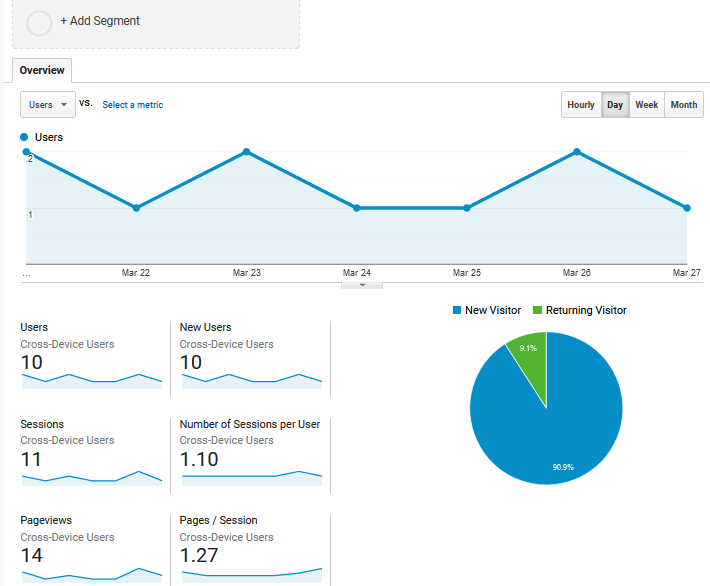In today’s highly connected environment, understanding how users interact with your digital assets across multiple devices is crucial. So, let’s dive right in and explore the magic of custom segments for tracking cross-device behavior.
First off, you may wonder why cross-device tracking is important. Well, the answer is simple: users often engage with your content using different devices, such as smartphones, tablets, and desktops. As a savvy marketer, you need a clear understanding of user behavior to make data-driven decisions and optimize your campaigns. That’s where custom segments in Google Analytics come to the rescue.
In this blog post, we’ll unravel the secrets of cross-device tracking using custom segments. We’ll cover the basics of cross-device behavior, provide a primer on Google Analytics’ cross-device tracking capabilities, and guide you through the process of creating custom segments for cross-device analysis. Additionally, we’ll discuss optimizing your marketing strategy based on cross-device insights and share some best practices. So, buckle up and get ready for a wild ride into the world of cross-device tracking!
Table of Contents
ToggleUnderstanding Cross-Device Behavior

Before we dive into custom segments, let’s take a moment to understand cross-device behavior. Simply put, cross-device behavior refers to how users interact with your website or app using various devices. For instance, a user might browse your online store on their smartphone, add items to their cart, and then complete the purchase on their desktop. Tracking these interactions across devices is essential for a comprehensive understanding of your audience’s behavior.
Now, you may wonder how cross-device behavior affects your marketing strategy. Well, here’s the deal:
- Attribution: Cross-device tracking helps you accurately attribute conversions to specific marketing channels, allowing for better optimization of your marketing budget.
- User experience: By analyzing cross-device behavior, you can identify potential issues in your website or app’s design, leading to an improved user experience.
- Personalization: Cross-device insights enable you to create more personalized marketing campaigns, resulting in increased engagement and conversions.
- Retargeting: Understanding cross-device behavior is vital for retargeting campaigns, as it allows you to target users with relevant ads on the devices they use most frequently.
So, it’s clear that mastering cross-device behavior is crucial for your digital marketing success. Now, let’s see how Google Analytics can help you keep tabs on cross-device interactions using custom segments.
Google Analytics: A Primer on Cross-Device Tracking
Before diving into custom segments for cross-device tracking, let’s explore how Google Analytics enables cross-device tracking. Google Analytics’ User-ID feature is the key to unlocking insights about your audience’s behavior across multiple devices.
Here’s a quick rundown of how User-ID works:
- Unique ID: When a user logs into your website or app, Google Analytics assigns them a unique ID. This ID follows the user across various devices, allowing you to track their interactions.
- Data integration: The User-ID feature connects data from different sessions and devices, providing a holistic view of user behavior.
- Enhanced reporting: With User-ID enabled, Google Analytics offers additional reports that give deeper insights into cross-device behavior.
Now, you might be wondering how to set up User-ID in Google Analytics. Worry not, as it’s easier than you might think:
- Enable User-ID: In your Google Analytics account, navigate to the “Admin” tab, select “Tracking Info,” and then click on “User-ID.” Follow the prompts to enable the feature.
- Modify tracking code: Update your website or app’s tracking code to include the User-ID. This process may vary depending on your platform, but Google Analytics provides comprehensive documentation to guide you.
- Test and verify: Once you’ve implemented User-ID, test it to ensure it’s working correctly. Google Analytics offers a real-time report that shows active users with User-ID, making it easy to confirm your setup.
With User-ID in place, you’re now ready to create custom segments to analyze cross-device behavior. Let’s jump into that next!
Creating Custom Segments for Cross-Device Behavior

Now that we’ve got the User-ID feature set up, it’s time to create custom segments for cross-device behavior analysis. Custom segments allow you to isolate and analyze specific data points in Google Analytics, such as users who interact with your site across multiple devices.
Follow these steps to create custom segments for cross-device behavior:
- Head to Google Analytics: Log into your account and navigate to the reporting view where you want to create the custom segment.
- Access segments: Above the main report graph, click on “+ Add Segment” to open the segment builder.
- Start from scratch: Click on “+ New Segment” to create a custom segment tailored to your needs.
- Configure the segment: In the segment builder, give your custom segment a meaningful name (e.g., “Cross-Device Users”). Then, go to the “Advanced” tab, select “Conditions,” and set up the following filters:
- Filter: Choose “User ID” as the filter dimension.
- Condition: Select “matches regex” from the condition dropdown.
- Value: Enter a regular expression that matches your User-ID pattern. For example, if your User-IDs are alphanumeric strings, you might use a regex like “[a-zA-Z0-9]+”.
- Test and save: Verify that your custom segment captures the intended audience by checking the “Summary” tab. If everything looks good, click “Save” to finalize your custom segment.
Congratulations! You’ve created a custom segment for cross-device behavior. With this new segment in place, you can start analyzing how users interact with your site or app across different devices. So, let’s get to the fun part—putting these custom segments to work!
Analyzing Cross-Device Data with Custom Segments
With your custom segment for cross-device behavior in place, it’s time to analyze the data and uncover valuable insights. Here’s how to use this segment to better understand your users and optimize their experience:
- Apply the custom segment: To view reports with your cross-device segment applied, click on “+ Add Segment” and select the segment you just created.
- Explore key metrics: Pay attention to metrics that can help you understand cross-device user behavior, such as:
- Bounce rate: Is there a significant difference in bounce rates between single-device and cross-device users? This could indicate a need for device-specific optimization.
- Conversion rate: Compare conversion rates to see if cross-device users are more likely to complete desired actions.
- Average session duration: Are cross-device users spending more or less time on your site or app? This could reveal insights into user engagement.
- Dive into specific reports: Use your custom segment in various reports to analyze cross-device behavior further. For example:
- Channels report: Identify which channels drive the most cross-device traffic, helping you allocate resources more effectively.
- Behavior Flow report: Understand how cross-device users navigate your site, and identify any bottlenecks or opportunities for optimization.
- Devices report: Compare the performance of different devices and optimize your site or app for the most popular ones.
- Monitor over time: Regularly review your cross-device custom segment to track changes in user behavior and identify trends.
Remember, the goal is to use these insights to make informed decisions that enhance user experience and boost conversions. By continually monitoring and optimizing cross-device behavior, you’ll be well on your way to creating a seamless experience for all your users, no matter which device they’re using!
Optimizing Your Marketing Strategy with Cross-Device Insights
Having analyzed your cross-device data, it’s time to put those insights to work and optimize your marketing strategy. Here’s a step-by-step guide to making the most of your findings:
- Identify high-performing channels: Use your custom segment to pinpoint channels that drive the most cross-device traffic. Then, invest more resources into these channels to maximize engagement and conversions.
- Target users with device-specific content: Create content tailored to the devices your audience uses most. For example, mobile users might prefer shorter, bite-sized content, while desktop users may enjoy longer articles or videos.
- Streamline the user experience: Ensure a seamless transition between devices by making your site or app responsive and easy to navigate. Test your site’s load times and eliminate any technical issues that might hinder cross-device use.
- Personalize your marketing efforts: Use the insights from your custom segment to deliver personalized marketing messages based on users’ device preferences. For instance, consider sending mobile app promotions to users who primarily interact with your brand on mobile devices.
- Revisit your attribution model: As cross-device behavior becomes more prevalent, consider adopting a multi-touch attribution model to account for the complex customer journey. This way, you’ll gain a more accurate picture of your marketing performance.
- Monitor and adapt: Regularly review your cross-device custom segment and adjust your marketing strategy accordingly. Stay ahead of the curve by continuously refining your tactics based on the latest data.
In conclusion, understanding cross-device behavior is crucial for crafting a successful marketing strategy. By leveraging custom segments in Google Analytics, you can gain valuable insights to optimize your campaigns and ultimately boost conversions. So go ahead, dive into the world of cross-device tracking, and watch your marketing efforts soar!
Best Practices for Cross-Device Tracking and Custom Segments
Now that you’re familiar with cross-device tracking and custom segments, let’s explore some best practices to ensure you get the most out of your efforts. By following these tips, you’ll be well on your way to becoming a cross-device tracking pro!
- Use a consistent User ID: To accurately track users across devices, ensure you’re assigning a unique and consistent User ID to each visitor. This will help you paint a clearer picture of their journey, regardless of the device they’re using.
- Segment wisely: When creating custom segments, be specific and focused. Avoid segmenting users based on too many variables, as this might dilute the insights you gain. Instead, concentrate on key variables that align with your marketing goals.
- Keep it simple: Don’t overcomplicate your custom segments. Stick to the most relevant dimensions and metrics, and avoid adding unnecessary filters. Remember, less is often more!
- Validate your data: Before drawing any conclusions from your custom segments, double-check your data for accuracy. Look for any discrepancies or anomalies and address them before making any strategic decisions.
- Share your findings: Cross-device insights can benefit multiple teams within your organization. Collaborate with colleagues from various departments, such as marketing, product development, and customer service, to ensure everyone is on the same page and working towards common goals.
- Stay up to date: Google Analytics is constantly evolving, so it’s essential to stay informed about the latest updates and features. Subscribe to industry newsletters and follow relevant blogs to ensure you’re leveraging the platform to its full potential.
In a nutshell, effective cross-device tracking with custom segments requires a combination of attention to detail, strategic planning, and collaboration. By adhering to these best practices, you’ll be well-equipped to make data-driven decisions that propel your marketing efforts to new heights. Happy tracking!
Final Word
In conclusion, understanding and leveraging cross-device behavior is crucial for modern marketers looking to make the most of their digital campaigns. Custom segments in Google Analytics serve as an invaluable tool to help you dig deep into cross-device data and extract valuable insights.
By mastering the art of creating custom segments tailored to your marketing objectives, you’ll be able to paint a clearer picture of your audience’s journey across devices. Furthermore, these insights will empower you to optimize your marketing strategy and deliver targeted messaging that resonates with your audience.
Remember, the key to success lies in staying informed about the latest Google Analytics features, segmenting wisely, and collaborating with your team to implement data-driven strategies. With these tips in mind, you’ll be well on your way to becoming a cross-device tracking expert and driving even greater results for your business.
So, go forth and conquer the world of cross-device tracking with custom segments. Your audience—and your bottom line—will thank you for it!






